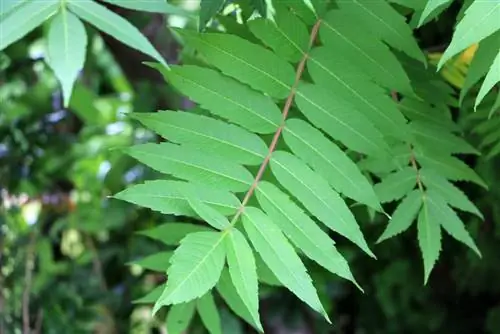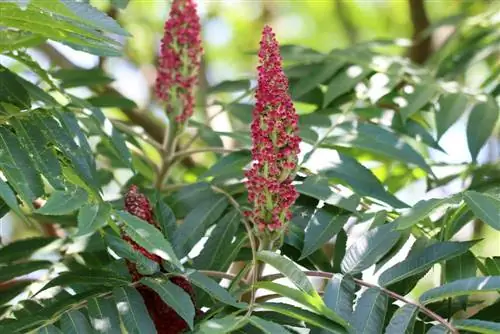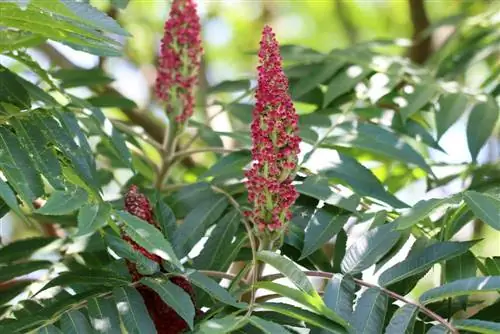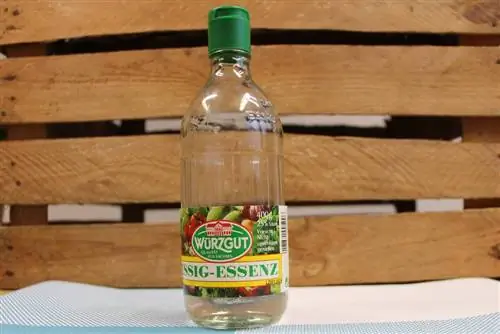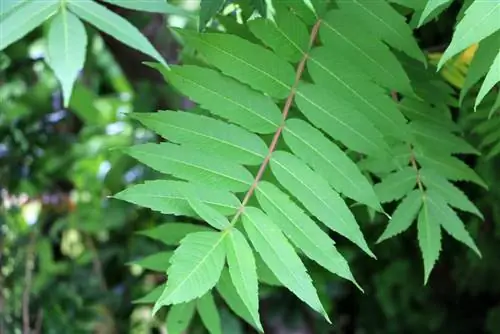- Author admin [email protected].
- Public 2023-12-17 03:39.
- Last modified 2025-01-24 12:45.
The vinegar tree is originally from the eastern USA and Canada. The tree came to Europe as an ornamental tree for parks in the 17th century. In the second half of the 20th century it found its way into gardens and green spaces. The German common name deer cob sumac comes from the strong, brown, felty, hairy young branches of the vinegar tree, which are reminiscent of deer antlers covered with bast.
Profile
- botanical name: Rhus typhina, syn.: Rhus hirta
- Plant genus/family: Rhus / Sumac family (Anacardiaceae)
- Synonyms: Deer butt sumac
- Growth: multi-stemmed shrubs with a wide crown; up to seven meters high (outdoors), two to three meters in the pot
- Flower: Spikes or whorls (15 to 20 centimeters long), green, inconspicuous
- Flowering time: June to July
- Leaves: deciduous, green, pinnate; Autumn color: yellow, then orange, bright crimson red in October (decorated leaves)
- Fruit: red, fruit decoration
- Toxicity: slightly toxic (leaves and fruits)
- Use: Ornamental trees
Location
Vinegar trees grow best in sunny locations. The plants also tolerate a partially shaded spot. Rhus typhina tolerates warm and dry urban climates very well.
Floor
Rhus typhina has no special demands on the soil. Ideal is a
- sandy
- permeable
Soil, as the plant cannot tolerate waterlogging. You should also pay attention to the pH value. Because the deer butt sumac does not like very calcareous soils. It has no special requirements when it comes to nutrient requirements. It can cope with both dry, sandy soils and dry, nutrient-rich substrates. A substrate mixture with sand has proven successful in pot cultivation as it creates permeable conditions. At the bottom of the planter you should create a drainage layer made of gravel or shards of pottery to prevent waterlogging. You should also place the bucket on a solid surface or on a saucer. Because roots that grow out of the drainage hole can form runners in the soil.
Planting time
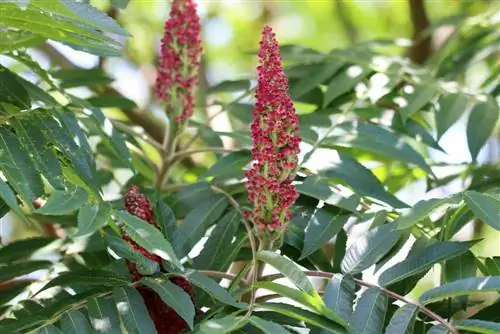
The best planting times for Rhus typhina are in autumn and spring.
Root barrier
The extensive root system of vinegar trees spreads shallowly into the upper layers of the soil. In order to avoid the resulting uncontrolled spread of the plants, you should create a root barrier when planting them in the garden. A bottomless stone container or a bottomless rain barrel is suitable for this. Despite the root barrier, the vinegar tree should have enough space so that it can develop well in the first few years. If the shrub doesn't have enough space, it will wither over the years. Therefore, the ideal diameter of the root barrier is two meters.
Tip:
Pond liner is not suitable as a root barrier for vinegar trees. The strong roots have no problem drilling holes in the film and subsequently growing through.
Plant Neighbors
Rhus typhina is suitable as a solitary plant or in groups. Its autumn color is particularly effective in front of evergreen hedges. Its bright autumn leaves can be combined well with autumn colors such as asters or chrysanthemums.
Pouring
Vinegar trees are easy-care plants that - when planted outdoors - only need to be watered in prolonged drought. In container cultivation, however, you should always keep the plants moist.
Fertilize
You don't need any special fertilizer for the vinegar tree. Regular fertilization is not necessary. Fertilizer application is only necessary if
- the tree is stunted or
- growth is stagnating.
In these cases, Rhus typhina is happy about compost. You should distribute this on the tree disc. Under no circumstances should you incorporate the compost into the soil. There is a risk that the roots will be injured and the plant will sprout uncontrollably from these wounds.
Tip:
When grown in containers, the deer sumac enjoys regular fertilizer applications.
Cutting
Vinegar trees do not need to be cut. On the contrary, this care measure actually promotes the uncontrolled sprouting of the bushes, as up to three new shoots can form at the interfaces. Nevertheless, you can use the scissors to
- to correct the crown
- adjusting the size of the shrub (pruning)
- to counteract baldness (thinning)
Tip:
You should only carry out a radical cut back close to the ground if the vinegar tree gets too tall or needs to be removed, as cutting close to the ground promotes the formation of runners.
Time
The ideal time to prune is when the leaves of the bush have fallen off. Alternatively, you can also carry out the cut in the spring before new growth appears. You can cut individual branches and water shoots throughout the entire growing season.
Blending
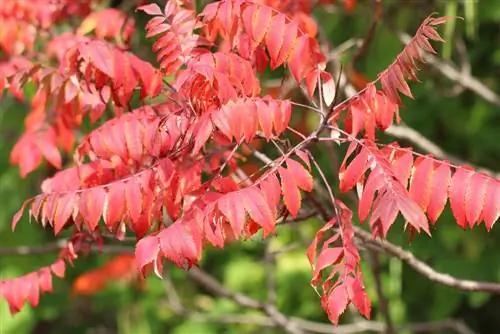
Since Rhus typhina grows very densely and branched, over time only little light penetrates the interior of the shrub. This results in the plant no longer bearing leaves inside. To prevent this baldness, you should thin out the plant regularly. This will
- intersecting pointer cut off
- stunted and dried branches removed
Only branches remain at a distance of 20 centimeters from each other.
pruning
To prevent Rhus typhina from developing too many new shoots, you should only cut off as many branches as necessary. How to use the scissors correctly:
- cut at least three to five centimeters above a sleeping eye
- Place the pruning shears at a slight angle
- make a smooth cut (no bruising)
Tip:
Since the milky sap of the vinegar tree can cause skin irritation, you should wear gloves when cutting.
Toxicity
According to the Bonn Poison Center, Rhus typhina is slightly toxic to humans. Poisonous parts of plants are leaves and fruits. The critical dose of toxic tannins and fruit acids is only reached after larger amounts have been consumed. Possible symptoms include:
- Stomach and intestinal irritation
- Vomiting
Source:
Transplanting & Repotting
You can transplant young vinegar trees without any problems. For older people, this step is more difficult due to their size, but is still manageable. In container culture, repotting into a larger planter takes place at the latest when the roots grow out of the drainage hole.
Tip:
Vinegar trees can be easily cultivated in pots.
Wintering
Vinegar trees can tolerate winter temperatures down to minus 23.3 degrees Celsius. However, when growing in a container, you should protect the tree from cold and frost by covering the planter with a cold protection fleece.
Propagate
In order to propagate Rhus typhina in a controlled manner, cuttings and root cuttings are suitable. You can also simply cut off a root runner and plant it in the new location. The optimal time for this form of propagation is in autumn or early spring.
Cuttings
Two-year-old shoots of the vinegar tree are ideal for propagation with cuttings. To obtain cuttings, follow these steps:
- cut off suitable shoots in early winter
- Remove shoot tip
- Divide the shoot into cuttings approximately 15 centimeters long
- at least two nodes per cutting
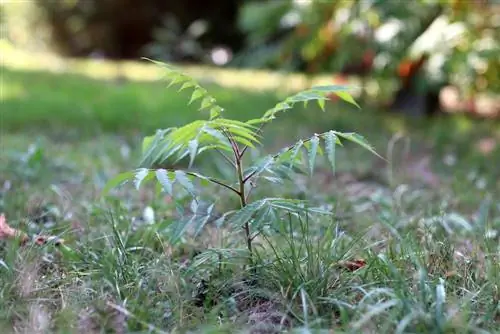
To propagate, follow the instructions below:
- Cut the bottom end of the cutting diagonally
- Trim the top end with a straight cut
Place the cutting in a plant pot with a mixture of sandy soil and coconut fibers
- Seeding depth: half of the cutting
- place in a bright and cool place (temperature: six to twelve degrees Celsius)
- Keep substrate continuously moist
- Planting cuttings in summer
Root cuttings
To obtain root cuttings, proceed as follows:
- cut off small parts of the root runners on a frost-free winter day
- ideal thickness: one centimeter
- divide into five to ten centimeter long cuttings
Tip:
The mother plant should retain approximately two thirds of its roots.
So that the root cuttings develop well, follow the instructions below:
- Cut off the root pieces at the bottom at an angle
- cut straight at the top
Place the cutting in a plant pot with a mixture of sandy soil and coconut fibers
- Root cutting completely surrounded by the substrate
- Cover the substrate with a thin layer of gravel
- Place root cutting in a cool place
- water sparingly regularly
- put outdoors in spring
- plant in late summer and autumn
Remove
Vinegar trees have an intense urge to spread, which leads to native plants being displaced. There are various options to curb this uncontrolled growth or remove the vinegar tree:
- Pulling out root shoots and rashes
- Removal of trees and rhizomes
- Destruction of the root network in the area
- Limiting large inventories
Tip:
The larger the vinegar tree, the more complicated it is to remove.
Pull out root shoots & cankers
In this variant, all young plants are destroyed. In addition, the mother plant is weakened so that it no longer produces new shoots. Proceed as follows:
- Carefully pull root shoots out of the ground
- Tear out as many roots as possible
- Pull root runners out of the ground with a joint knife
- Carry out the process consistently for two to four years
- Removal of trees and rhizomes
To remove the entire tree including the rootstock, the following steps are necessary:
- Cutting down a tree
- Dig up tree stump and rootstock
- Roots are up to two meters deep
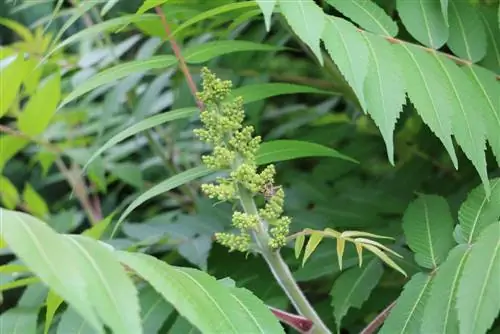
If digging is not possible, you should proceed as follows:
- Saw the tree stump close to the surface
- notch deep grooves in the wood
- Fill grooves with compost (accelerating the rotting process)
Note:
You should avoid using Roundup products as they pollute the environment and are also not very promising.
Destroy root network
These measures involve removing the flat lateral roots of the vinegar tree. Follow the instructions below:
- Remove soil around the vinegar tree (radius: 10 meters)
- Depth: up to 30 centimeters
- remove all root parts from the soil
- If necessary, repeat the measure every two to four years
Tip:
Before spreading the removed soil, it must be sieved thoroughly. Because even small pieces of roots can grow new vinegar trees.
Restriction of large stocks
To contain or remove large or extensive populations, proceed as follows:
- Cutting the inventory from the outside in
- Tear out root shoots with roots as far as possible
- This approach reduces the size of the core zone from year to year. At the end of the measure the mother plant is killed.
Diseases and pests
Vinegar trees are considered robust plants. In the spring, an infestation with “cuckoo saliva” is possible. These are cicada larvae that feed on the shoots of the tree. You can recognize the infestation by white clumps of foam on leaves and shoots. As a countermeasure, spraying with a sharp jet of water is recommended.
If an infection with honey fungi, also known as honey mushrooms, occurs, the tree often takes years to grow or dies in a very short space of time. Therefore, the fungi must be completely removed. However, the risk of infection is limited because the vinegar tree is not very susceptible to infestation.

